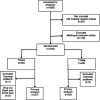Echocardiographic parameters during prolonged targeted temperature Management in out-of-hospital Cardiac Arrest Survivors to predict neurological outcome - a post-hoc analysis of the TTH48 trial
- PMID: 33608045
- PMCID: PMC7893899
- DOI: 10.1186/s13049-021-00849-7
Echocardiographic parameters during prolonged targeted temperature Management in out-of-hospital Cardiac Arrest Survivors to predict neurological outcome - a post-hoc analysis of the TTH48 trial
Abstract
Background: Transthoracic echocardiographic (TTE) indices of myocardial function among survivors of out-of-hospital cardiac arrest (OHCA) have been related to neurological outcome; however, results are inconsistent. We hypothesized that changes in average peak systolic mitral annular velocity (s') from 24 h (h) to 72 h following start of targeted temperature management (TTM) predict six-month neurological outcome in comatose OHCA survivors.
Methods: We investigated the association between peak systolic velocity of the mitral plane (s') and six-month neurological outcome in a population of 99 patients from a randomised controlled trial comparing TTM at 33 ± 1 °C for 24 h (h) (n = 47) vs. 48 h (n = 52) following OHCA (TTH48-trial). TTE was conducted at 24 h, 48 h, and 72 h after reaching target temperature. The primary outcome was 180 days neurological outcome assessed by Cerebral Performance Category score (CPC180) and the primary TTE outcome measure was s'. Secondary outcome measures were left ventricular ejection fraction (LVEF), global longitudinal strain (GLS), e', E/e' and tricuspid annular plane systolic excursion (TAPSE).
Results: Across all three scan time points s' was not associated with neurological outcome (ORs: 24 h: 1.0 (95%CI: 0.7-1.4, p = 0.98), 48 h: 1.13 (95%CI: 0.9-1.4, p = 0.34), 72 h: 1.04 (95%CI: 0.8-1.4, p = 0.76)). LVEF, GLS, E/e', and TAPSE recorded on serial TTEs following OHCA were neither associated with nor did they predict CPC180. Estimated median e' at 48 h following TTM was 5.74 cm/s (95%CI: 5.27-6.22) in patients with good outcome (CPC180 1-2) vs. 4.95 cm/s (95%CI: 4.37-5.54) in patients with poor outcome (CPC180 3-5) (p = 0.04).
Conclusions: s' assessed on serial TTEs in comatose survivors of OHCA treated with TTM was not associated with CPC180. Our findings suggest that serial TTEs in the early post-resuscitation phase during TTM do not aid the prognostication of neurological outcome following OHCA.
Trial registration: NCT02066753 . Registered 14 February 2014 - Retrospectively registered.
Keywords: Cardiac arrest; Echocardiography; Out-of-hospital cardiac arrest; Prognostication; Targeted temperature management.
Conflict of interest statement
AMG declares to have received speaking fee from Novartis and Merck Sharp and Dome (MSD). All other authors declare no conflicts of interest.
Figures


Similar articles
-
Effect of prolonged targeted temperature management on left ventricular myocardial function after out-of-hospital cardiac arrest - A randomised, controlled trial.Resuscitation. 2017 Jun;115:23-31. doi: 10.1016/j.resuscitation.2017.03.021. Epub 2017 Apr 2. Resuscitation. 2017. PMID: 28377297 Clinical Trial.
-
Prolonged targeted temperature management reduces memory retrieval deficits six months post-cardiac arrest: A randomised controlled trial.Resuscitation. 2019 Jan;134:1-9. doi: 10.1016/j.resuscitation.2018.12.002. Epub 2018 Dec 17. Resuscitation. 2019. PMID: 30572070 Clinical Trial.
-
A statistical analysis protocol for the time-differentiated target temperature management after out-of-hospital cardiac arrest (TTH48) clinical trial.Scand J Trauma Resusc Emerg Med. 2016 Nov 28;24(1):138. doi: 10.1186/s13049-016-0334-0. Scand J Trauma Resusc Emerg Med. 2016. PMID: 27894327 Free PMC article. Clinical Trial.
-
Prediction performance of scoring systems after out-of-hospital cardiac arrest: A systematic review and meta-analysis.PLoS One. 2024 Feb 1;19(2):e0293704. doi: 10.1371/journal.pone.0293704. eCollection 2024. PLoS One. 2024. PMID: 38300929 Free PMC article.
-
Targeted Temperature Management After Out-of-Hospital Cardiac Arrest: Integrating Evidence Into Real World Practice.Can J Cardiol. 2023 Apr;39(4):385-393. doi: 10.1016/j.cjca.2022.12.026. Epub 2023 Jan 4. Can J Cardiol. 2023. PMID: 36610519 Review.
Cited by
-
Factors predicting mortality in the cardiac ICU during the early phase of targeted temperature management in the treatment of post-cardiac arrest syndrome - The RAPID score.Resusc Plus. 2024 Aug 16;19:100732. doi: 10.1016/j.resplu.2024.100732. eCollection 2024 Sep. Resusc Plus. 2024. PMID: 39246407 Free PMC article.
-
Post cardiac arrest left ventricular ejection fraction associated with survival to discharge.Resusc Plus. 2024 Aug 10;19:100737. doi: 10.1016/j.resplu.2024.100737. eCollection 2024 Sep. Resusc Plus. 2024. PMID: 39228405 Free PMC article.
-
Updates on Post-Resuscitation Care. After the Return of Spontaneous Circulation beyond the 2021 Guidelines.Rev Cardiovasc Med. 2022 Oct 31;23(11):373. doi: 10.31083/j.rcm2311373. eCollection 2022 Nov. Rev Cardiovasc Med. 2022. PMID: 39076196 Free PMC article. Review.
-
Trend of Outcome Metrics in Recent Out-of-Hospital-Cardiac-Arrest Research: A Narrative Review of Clinical Trials.J Clin Med. 2023 Nov 20;12(22):7196. doi: 10.3390/jcm12227196. J Clin Med. 2023. PMID: 38002808 Free PMC article. Review.
-
Right atrium area is associated with survival after out-of-hospital cardiac arrest: a single-center cohort study.Echo Res Pract. 2025 Apr 14;12(1):9. doi: 10.1186/s44156-025-00072-5. Echo Res Pract. 2025. PMID: 40223106 Free PMC article.
References
-
- Nolan JP, Neumar RW, Adrie C, et al. Post-cardiac arrest syndrome: Epidemiology, pathophysiology, treatment, and prognostication: A scientific statement from the International Liaison Committee on Resuscitation; the American Heart Association Emergency Cardiovascular Care Committee; the Council on Cardiovascular Surgery and Anesthesia; the Council on Cardiopulmonary, Perioperative, and Critical Care; the Council on Clinical Cardiology; the Council on Stroke (Part 1) Int Emerg Nurs. 2009;17:203–225. doi: 10.1016/j.ienj.2009.01.001. - DOI - PubMed
Publication types
MeSH terms
Associated data
LinkOut - more resources
Full Text Sources
Other Literature Sources
Medical
Miscellaneous

